美国加油站的图片历史(英文)
Retail Fueling in Pictures
February 01, 2015 NACS
Like any successful industry, fuels retailing has evolved over the past 100 years. What was once an often ramshackle, stand-alone business is now a modern, high-volume operation with other profit centers to drive the business. View our slideshow for a look at some of the major milestones in the industry’s development.
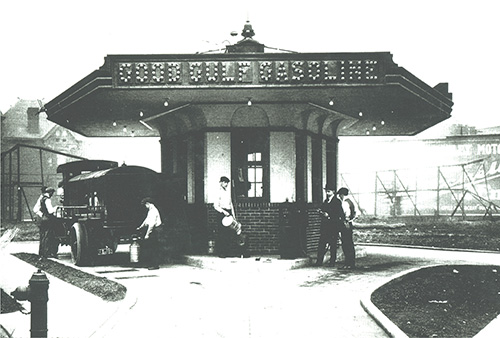
December 1, 1913: The First of an Industry
Gulf Refining Company opened the nation’s first drive-up service station on Baum Boulevard in Pittsburgh, Pennsylvania. It was designed and built specifically to sell fuel. On that first day, the station sold 30 gallons of gasoline — less than 1% of the daily sales volume of a fueling station today. All that remains at that first fueling location is a historical marker.
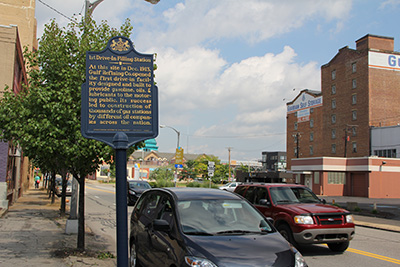
1913: Paving the Way
The Lincoln Highway Administration was established, along with a special fund for road improvements. (Not surprisingly, Baum Boulevard, site of the first gas station, was on the Lincoln Highway.) At the time, there were approximately 500,000 vehicles navigating almost exclusively dirt or gravel roads. Today, there are more than 250 million vehicles traveling on 3.98 million miles of paved roadways.
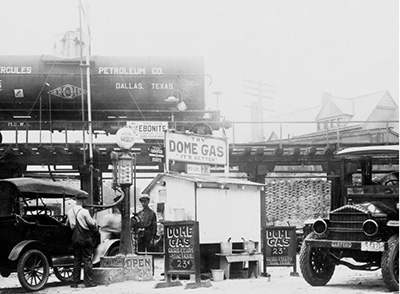
1920s: Demand Fuels Growth
The fueling industry skyrocketed in the late 1910s and through the 1920s. There were about 300,000 fueling outlets across the country — double the 152,000 fueling outlets today. These locations often were set up quickly to take advantage of increased fuel demand.
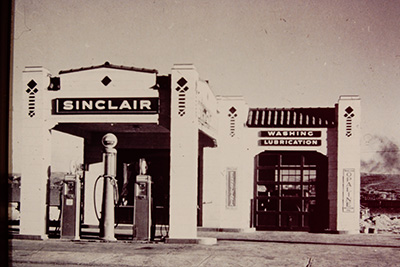
1920s: Fill ’Er Up
By the 1920s, curbside fueling was creating havoc, and accidents in bigger cities led to a ban on this service. Yet the practice remained popular in smaller towns. Most pumps featured a globe in which the fuel rose to the top before it was dispensed, proving to drivers that there was gas going into their vehicles.
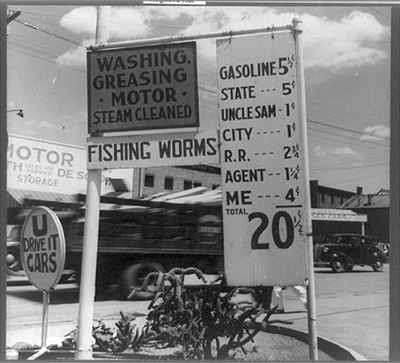
1930s: Sign of the Times
The first elevated gas signs date back to 1915 and focused on the brand. But price took center stage as cars went from a status symbol to a necessity. And during the Depression, what mattered most for many consumers was who had the lowest gas price.
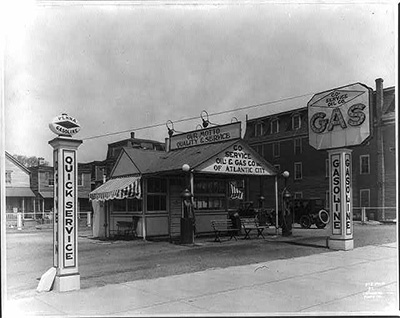
1930s: Selling Service
As the Depression deepened, competition for remaining fuel customers intensified. Car sales fell from 4.5 million units in 1929 to 2.7 million units in 1930 and 1.1 million in 1932. As retailers sought ways to draw in customers beyond price, they began developing and marketing services — such as clean restrooms. Stations also started offering bonuses for fill-ups, including free cigarettes, dolls, china and even chickens.
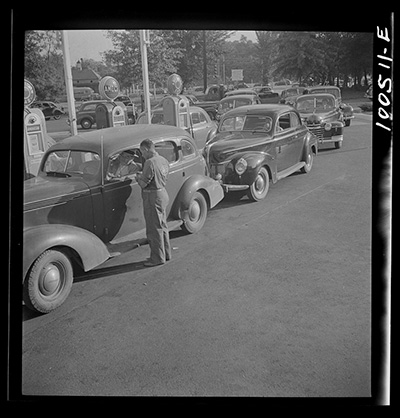
1940s: The Effects of War
The retail fueling industry continued to stagnate through World War II as critical supplies — like fuel — were rationed. Customers gathered at this Washington, D.C., station to find fuel before tougher restrictions took effect. Gasoline rationing also was used during the 1973-1974 oil crisis, and odd-even rationing was mandated in a handful of states during the 1979 oil crisis and briefly in New York and New Jersey following Superstorm Sandy in 2012.

1960s: Do It Yourself
The first remote self-service gas pumps were introduced on June 10, 1964, at a Big Top convenience store in Westminster, Colorado. The new technology gave convenience stores the ability to sell gasoline without adding additional labor. At the time, customers were still loyal to particular fuel brands, but the significantly lower prices for unbranded fuel combined with the lower costs of self-serve revolutionized the fueling industry. It didn’t happen overnight, of course. On that first day, fuels sales only totaled 124 gallons, but the modern era of self-serve fueling was born.

1960s: Making Gas Stations Beautiful
Mobil’s 1966 “Pegasus” canopy was in part designed to address concerns that U.S. first lady Lady Bird Johnson would seek to curtail the expansion of roadside gas signs and branding as part of her beautification project. This canopy was intended to mimic the Mobil logo’s round background so that customers would know it was a Mobil station, even without a sign indicating so. The station is still in operation in Dallas, Texas.
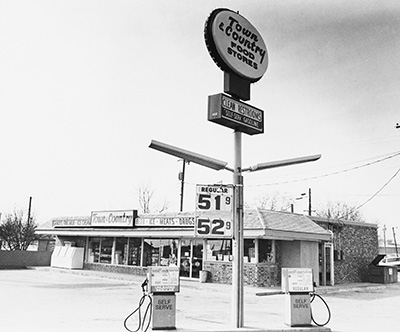
1970s: Self-Service Takes Off
Only 13 states permitted self-serve in 1964, but that number jumped to 42 by 1972. That loosening of restrictions, along with the oil price shock of 1973-1974, allowed self-serve to finally take hold. In 1973, convenience stores sold less than 1% of the fuel in the United States. By 1982, that figure topped 12% and it stands at around 80% today.
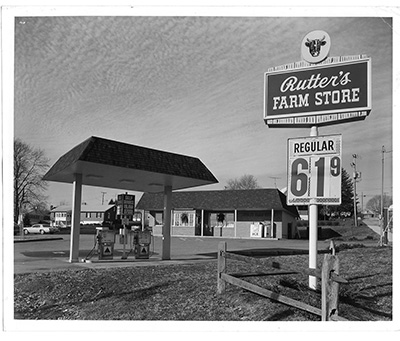
1970s: The Suburban Crowd
As Americans increasingly moved to the suburbs, fueling stations were there to meet the need. Unlike many stations near highways or along highly trafficked roads where they needed to stand out, suburban stations evolved to blend in, with many looking less like businesses and more like the houses in the surrounding community.
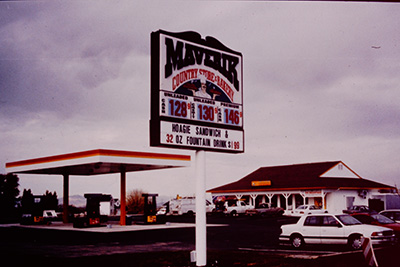
1970s: Improving the Experience
As fueling at convenience stores in the 1970s grew, so did the emergence and expansion of canopies above the fueling island to protect customers from the elements.
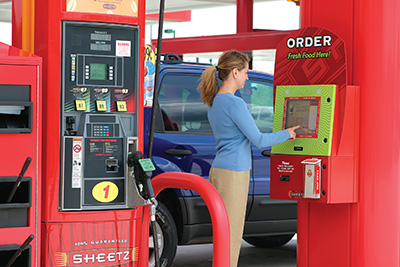
2000s: Technology Delivers Convenience
Using dispensers with a built-in credit/debit card reader, E-Z Serve and its subsidiary AutoGas in Abilene, Texas introduced pay-at-the-pump service in 1986. Only 13% of convenience stores had the technology by 1994, but 80% of convenience stores were using it by 2002. Now, virtually all stores offer pay-at-the-pump. Also in the early 2000s, some companies experimented with other types of kiosks at the pump, including allowing customers to order sandwiches that can be ready for pickup after the fueling is completed.
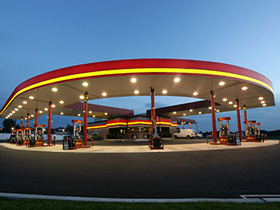
Today: Fueling America
Modern convenience stores can fuel upward of 30 vehicles at a time at some locations, 24 hours a day. And convenience stores sell more than 80% of the fuel purchased in the country. The average store sells approximately 4,000 gallons per day, but large-volume stores may sell five times that amount.
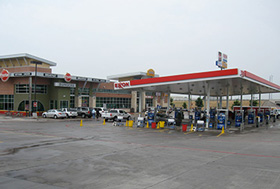
Today: Where the Profits Are
While 71% of a convenience store’s revenue dollars come from gasoline today, the bulk of a store’s profits come from in-store sales, particularly food and beverages. Because fuel retailers make three cents per gallon profit, they’re searching for new profit centers, such as foodservice, as well as new marketing strategies to entice customers to buy items inside the store.

全部 0条评论